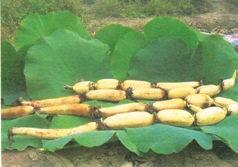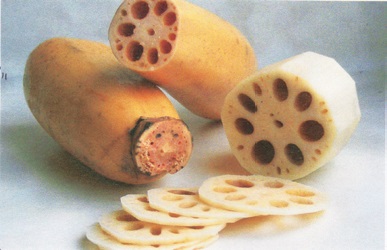
| What is Flavor and Fortune? |
| How do I subscribe? |
| How do I get past issues? |
| How do I advertise? |
| How do I contact the editor? |
Read 7002632 times
Connect me to:
| Home |
| Articles |
| Book reviews |
| Letters to the Editor |
| Newmans News and Notes |
| Recipes |
| Restaurant reviews |
| Article Index (all years, slow) |
| List of Article Years |
| Article Index (2024) |
| Article Index (last 2 years) |
| Things others say |
| Related Links |
| Log In... |
| Authors |
| Categories & Topics |
Lotus: a favorite Vegetable in Hubei
| by Wang Si |
Vegetables and Vegetarian Foods
Spring Volume: 2018 Issue: 25(1) pages: 15 to 17

One food reminds me of my missing where I grew up,. It is the lotus, and just thinking about it fills me with homesickness. This food, mistakenly called lotus root, is not a root but a rhizome. It grows widely all over China and is one of the most popular foods in Hubei where I was born and raised. It certainly is a favorite food of mine.
Several archaeological discoveries confirm its early existence in China. Botanically known as Nelumbo nucifera, it was eaten in my country for thousands of years. We know that because leaves from it were found fossilized in the 1940s in the Qinghai Province dated from a million years ago. In 1970, when the Mawangdui Han Tombs were unearthed in Changsha in the Hunan Province, people found slices of this vegetable in a lacquered funerary object. They were only dated from the early part of the 2nd century BCE.
In 1973, two lotus seeds, dated from five thousand years ago were excavated in Zhengzhou in the Henan Province. Ancient lotus pollen was found at the Hemudu site in the Zhejiang Province and they were some seven thousand years old. Historical literature talks about this vegetable in the Book of Songs written some time between the 11th to the 6th centuries BCE. And, in Sorrow after Departure there are writings about it by Qu Yuan (340 – 278 BCE).
There is a controversy, not its age, but whether China or India first cultivated the lotus. Historical People in both countries do take credit for it, and both are fond of eating it. Whenever it is spoken about or one reads about it, its beautiful flowers are mentioned. Seems they always smell good when blooming, and are sweet and wonderful.
The lotus flower does represent many good things in my culture. The flower represents purity and is found with sacred intent in religious paintings and sculptures; and is used in many common rituals. Among intellectuals, it is considered a gentleman’s flower because it grows up from the mud and does stay pure. It has huge leaves, most are almost round, lie flat, and stand for both family reunion and peaceful living.
People use lotus leaves to wrap food when cooking it, particularly if it is in small pieces. They do not eat the leaves but love their aroma when it is cooked that way. One typical dish in Hangzhou made that way is ‘Beggar’s Chicken. Lotus seeds, edible and symbolizing being fruitful and fertile, are very popular at weddings and other family ceremonies. I adore them fresh in summer and dried in all seasons, and I often use them when making desserts.
Their long fat rhizomes are my favorite part. There are various ways to cook them, each has its fans. This part of these plants grow horizontally, under water, and in the mud. They have hollow tubes running through them. I join all who like to stuff them with a myriad of things animal and vegetable. (See their picture on next page)
Around 540 CE, Jia Sixie wrote a book titled Qi Min Yao Shu that includes many basic techniques and traditional recipes. Intended for common people, this book did guide folk on how to best cultivate them. Later they read local views from the Ming and Qing Dynasties (1368 - 1644 and 1644 - 1911, respectively) advising where and how they were cultivated including in Eastern and Central China, Southern, Southwestern, and Northern places, and in Northeastern and Northwestern parts of my country.
Except in extremely cold areas, freshwater and irrigated fields are popular for their cultivation, and they are considered an alternative staple when grain shortages exist, as they have during China’s long history. There, many species are commonly used for their edible seeds and rhizomes, and their big beautiful leaves are commonly used ornamentally.
In my hometown, and in area of the Hubei Province, there are about twenty cultivars of the lotus plant. More than half are traditional varieties. For those that like to eat this vegetable as I do, two kinds are most appreciated for their taste, one juicier, sweeter, and crunchier; best cooked than sliced or stir-fried. The other kind is more starchy and some say it puckers the lips when eating it, but this one is delicious when steaming or stewing, particularly when adding meat in its preparation.
As a child, I did not like this variety, and it was on my list of vegetables that I was picky about, and sometimes still are. As to why, its fibers are annoying, and when I was young they made me think of spider webs. Widely planted and in my hometown, all are available in every season, prepared one way or another. However, then they were not really appreciated by my stomach. Now I love dishes made with all of them.
The most popular lotus dish in Hubei is Spareribs and Lotus Soup. I love it because it is fresh and tasty. Stir-fried, is another popular way to prepare this vegetable sliced, diced, or simply fried with ginger and salt, or fried with chili and vinegar.

I am reminded of a conversation in my hometown market last there with my mom. The vendor did ask, when she stopped and stared at a pile of these rhizomes, “Are they for soup or to stir-fry?” Then he showed her two kinds according to each possible preparation technique. Without this question, my mom would have checked the junction between sections to see if they looked and felt starchy. For those that did, they would know if they should be for soup or for a dish that stir-fries them.
One thing to know is what one finds between their dividing joints. Are they laden with oxygen or iron? Either could change color from white to blue, even black if soaked in fresh water as soon as they are peeled or chopped. There are also color differences particularly when using stainless steel or implements made of iron.
Gao Lian, a well-known writer born living in Hangzhou from 1573 to 1620 during the Ming Dynasty, wrote of his many experiences in a book titled Zun Sheng Ba Jian. There, he records preparing lotus starch. Now, people buy it prepared in supermarkets, but in his day they needed to make their own as it certainly was not available during Ming Dynasty times. Unlike other starches, to make it they needed two steps. The first to mix it with a little cold water, the second to add eight or nine times that amount of boiling water. They needed to stir it quickly at the same time so the starch would turn into a very light pink jelly; or they could add sugar or osmanthus, if preferred.
Candied lotus stuffed with glutinous rice was a Yua Mei favorite; he lived from 1716 to 1798 CE and recorded his preferences in his Sui Yuan Shi Dan volume. My favorite is to steam this starch made into balls. One needs some minutes to peel, rinse, and mash lotus rhizomes, then rub them back and forth on flat blades over a bowl. There are other steps, too. In my family, only my grandmother or an aunt, the one who is her eldest daughter, makes them to please me, and making them at home is complicated.
These balls are best served during Spring Festival; and great patience is needed to make them. My best memories of them are at big annual family gatherings. I miss them and can offer no recipe, but if you find an easy one, do share it with me. Another of my favorites is of this vegetable made in a soup. That recipe follows as does another using lotus in sandwiches, and still another stuffed with glutinous rice which you may know as sticky rice. Do make and enjoy them all!
| Spare Ribs and Lotus Soup |
|---|
2 sections lotus rhizomes, peeled and chopped, then soaked in cold water
1. Put lotus pieces in a large bowl, sprinkle on the salt
and shake the bowl to evenly distribute the salt; then
allow it to rest for ten minutes.
|
| Lotus and Pork Sandwiches |
|---|
1 section lotus rhizome, peeled and thinly sliced
1. Mix pork with scallion, ginger, salt, ground pepper,
sesame oil, and wine.
|
| Pickled Lotus Rhizomes |
|---|
2 or 3 lotus rhizomes, peeled and cubed or sliced
1. In a small pot, cover lotus rhizomes with water, add half
the salt, and boil for five minutes, then cool to medium.
|
| Lotus Stuffed With Sticky Rice |
|---|
2 lotus rhizome sections. Separated and scrubbed clean
1. Cut half inch end off each section of lotus and reserve.
|
| Lotus Seed Stuffed Cantaloupe |
|---|
1 cup lotus seeds
1. Put lotus seeds and baking soda in a small bowl and
cover with boiling water. Set this aside until cool. Rinse
and discard any green sprouted parts inside the seeds
and repeat covering them with boiling water and letting
them cool again, then chop them or cut each seed into
quarters. and put the lotus seeds in a steamer basket and
steam them for half an hour.
|

Copyright © 1994-2024 by ISACC, all rights reserved
Address
3 Jefferson Ferry Drive
S. Setauket NY 11720